I had the privilege of presenting, with Gerik Kimble, the keynote presentation at Washington State University’s inaugural Elevating Cougs conference, “Embracing Change for Employees and Leaders.”
This fun, easy-going presentation shares how embracing change benefits you along with practical advice for how to manage change for your teams.
Watch the presentation below or read our presenter notes.
Elevating Cougs is Washington State University’s largest employee development event across two days, three tracks, 80 sessions, 90 speakers, and 800 attendees.
Watch the Embracing Change Keynote Recording
Read the Presentation Notes
The goals for the presentation are to discuss what is change management, why it’s important, and why it’s necessary. We’ll also discuss the importance of accepting change and hopefully have some fun with that topic today.
Lastly, we’ll close out the session with an introduction to Prosci’s “ADKAR” framework and some takeaways to start you on your Elevating Cougs journey.
What is Change Management?

Gerik:
Change management is:
- helping people understand the reasons for an upcoming change,
- what the impacts of the change are, and;
- what are the expected outcomes or benefits of the change.
Paul and I are both certified change practitioners with Prosci and part of our jobs are to help the WSU community with upcoming changes particular to Workday.
Change is everywhere – not just at work. Individuals are more accepting of change when they are informed or empowered.
Gerik Kimble
Take my cell phone for instance. Updates are constantly pushed to my phone. Most of the time, I just install them as I’m prompted to do so (without much thought). Occasionally, I see press releases regarding security updates. In those cases, I’m much more likely to seek out the update and install it.
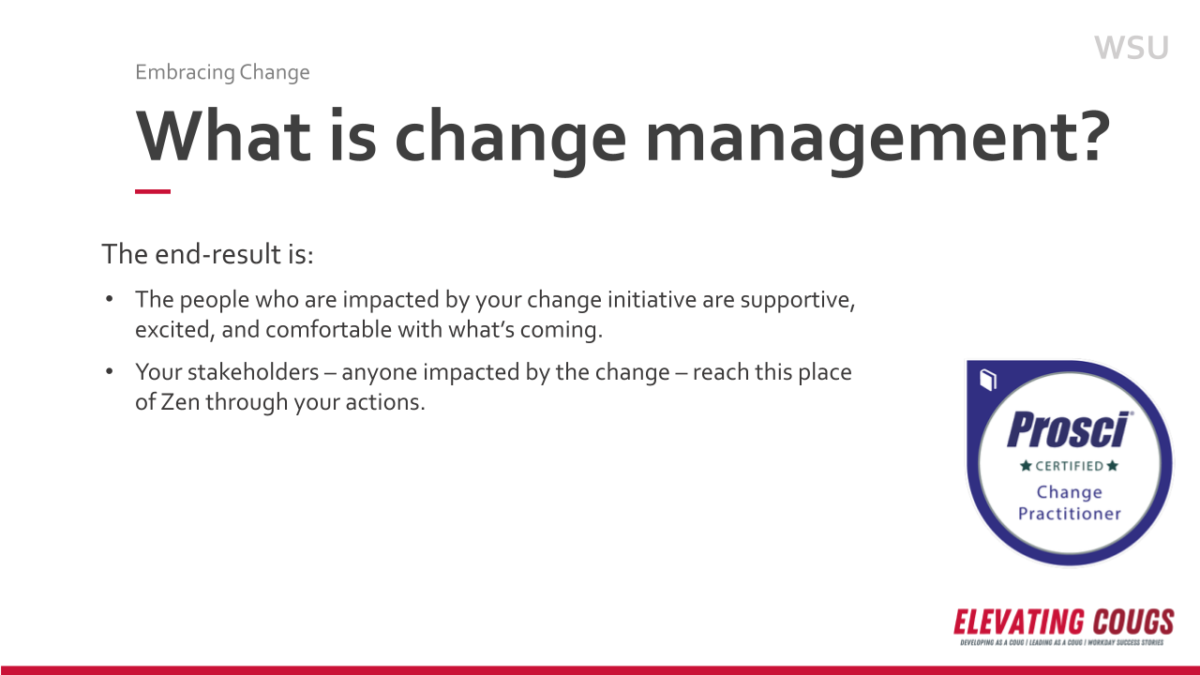
The goals of change management are to ensure the people impacted by the change are supported, excited, and comfortable with what’s ahead.
Here at WSU for Workday updates, our goal is for our employees to be accepting of change, to expect it, and to be zen with the outcomes.
Now, do all changes go well?? No!!
But, individuals who are aware of the change, support the change, are often the same individuals who help us navigate unexpected outcomes, rocky situations, and resolve issues.
Why is Change Management Important?

Paul:
Simply put, no-one likes being left in the dark.
When there’s a lack of communications, or no active effort to help people understand why change is happening, that’s going to lead to an increase in frustrations and stress. And WSU employees have enough of that already with high workloads – something that was widely noted in this year’s Employee Engagement Survey.
So, helping people understand what’s happening and why, can help bring a sense of calm and hope and even excitement around our work days.
For example, imagine those laborious and dreaded processes that just drag you down – we all have them from time to time.
Now, let’s say you hear that the processes are going to be changing. But you don’t know how or when or what the impact is to you.
Is your first reaction that they’re changing for the better? Or is the expectation that they’ll have extra steps and signatures added to them?
Without change management generating excitement and understanding, it’s easy for us to imagine the worst case scenario rather than what’s happening – which is the processes are changing for the better.
Another reason change management is important, is it demonstrates the empathy the project team and managers have for those who are impacted by the change.
That empathy comes through in both the language used in the communications and materials that are produced and also by the fact that the project team wants you to know what’s going on so you can get comfortable with the change and prepare for it.
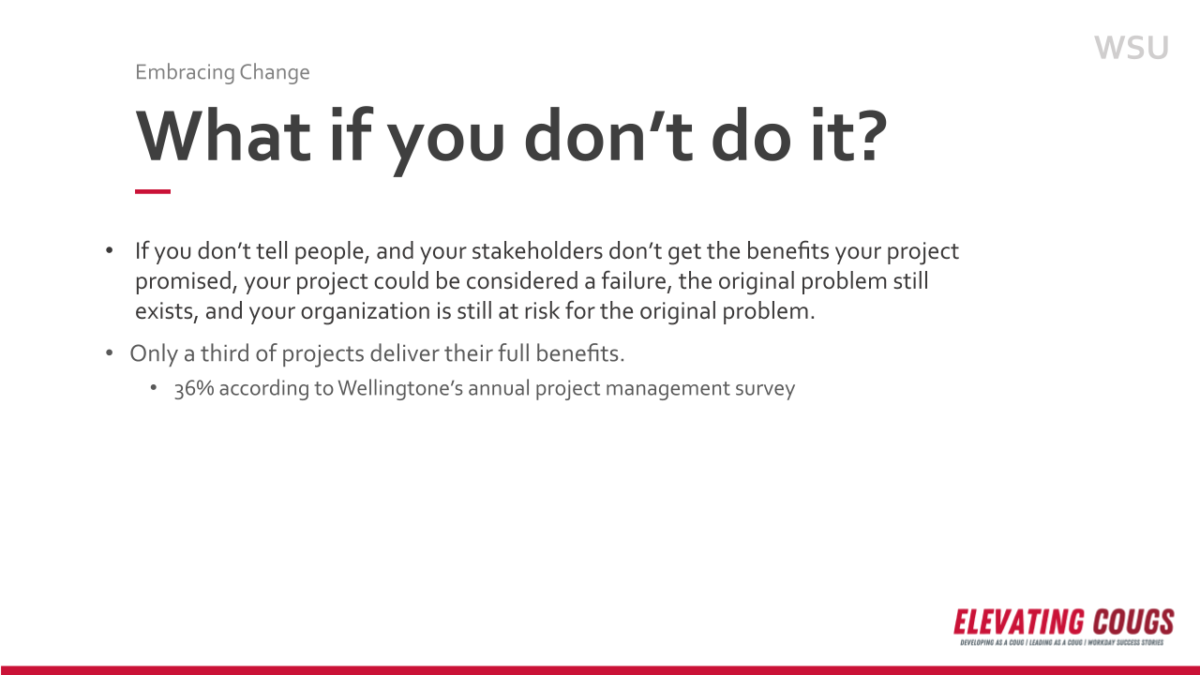
If we don’t take the time to help people prepare for the change, then when the project is delivered, people will be resistant or lack the knowledge they need to adapt to the change and the benefits won’t be realized.
Which results in the believe that the change initiative has failed, and the reason for the project – to solve a problem – still remains.
Here’s a sobering statistic that highlights this:
- Annual surveys carried out by an international project management consultancy called Wellingtone, regularly find that only 36% of completed projects deliver their full benefits.
Think about that for a moment.
Only 1 in every 3 projects does what it says on the tin.
That’s like buying 3 pairs of new jeans and only one of them fits. Something I’ve found recently that sadly applies. So if not all of my jeans fit, why did I buy 3 pairs of them? Because I liked the colour and the styling.
So, to wear them, and enjoy the full advantage of their comfort and fantastic looks, I need to get out of my chair a little more often, which I’m OK with, and eat a little less chocolate – which I say boo to, by the way.
The end result is, I’m fitter and I’m able to fit into all my new jeans.
I know what I need to do to wear the jeans, so having 3 pairs of jeans I look forward to wearing is a win. But if I didn’t know what actions I needed to take and what the expected benefits were, buying the jeans would seem like a waste of time and effort and money.
Projects can be seen the same way too.
So, we’ve seen why practicing change management is important. But what about us, when we’re faced with change? How important is it to accept change?
The Importance of Accepting Change

Gerik:
Change is coming faster and faster.
Many very smart people study the rate of change in society. Some say the rate of change is doubling. At any rate, we are saying that change is constant so let’s embrace it!
So what is changing? Everything!
Our systems, how we dress, how we work, where we work, how meetings held, how information is shared.
Many years ago, I had a chance to watch comedian Brian Regan at Beasley Coliseum. Brian is known for being a clean comedian. In preparing for this presentation, I thought I should quote someone very smart but that also fits my personal style. So, here is what Brian says:
Be adaptive, flexible, and never stop learning. The rate of change will never stop, and neither should you
Brian Regan
Here I am, today…

And here I am at 70…
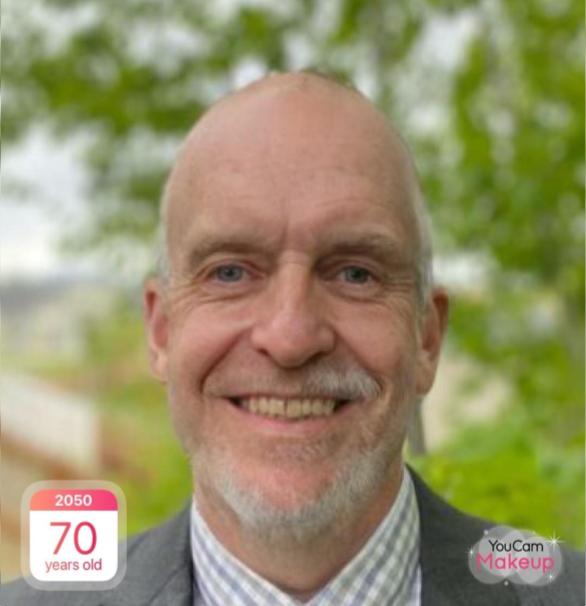
Paul, did you notice I still have some hair? Shoot, do I have more hair?? Look at those teeth! And I have a beard!!!!!!
Oh man! I better embrace change.
What if We Don’t Communicate About the Work We’re Doing?
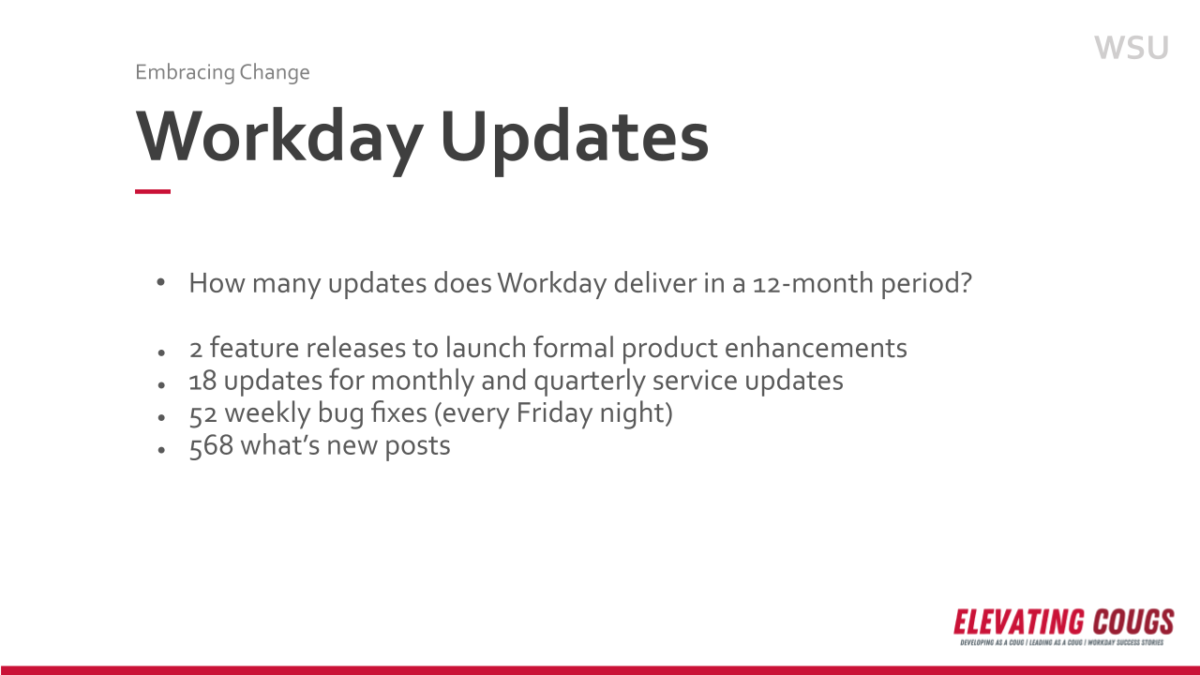
Gerik:
How many updates does Workday deliver in a 12-month period?
Workday has:
- 2 feature releases to launch formal product enhancements.
- 18 updates for monthly and quarterly service updates.
- 52 weekly bug fixes (every Friday night).
- 568 what’s new posts.
Paul:
What would happen if we didn’t communicate about the new functionality in Workday?
Everyone would think that Workday was static, that it wasn’t moving forward. That people were being asked for their improvement suggestions and then being ignored. Which is the furthest from the truth.
Here’s an example: our Workday training materials.
When I first took over the Change & Communications team 12 months ago, one of the big asks was to improve our reference guides. Now if we didn’t keep communicating in the Workday Digest about the new guides and improvements to existing ones, people might only see changes to the handful of guides they use regularly. They’d just think a couple of guides had been updated and not the hundreds that have been worked on.
Over the last 12 months the knowledge base has gone from an average of 6000 visits a month to over 7000 with a high of over 9000 visits.
Now, people wouldn’t be referring to the knowledge base more and more if they didn’t know about the improvements.
Without change management communications you run into the issue of perception versus reality: the perception only a handful of guides have been updated when in reality it’s over a hundred.
Here’s my favourite analogy when it comes to that perception versus reality issue.
Imagine a steam train racing through a long, dank, tunnel.

I know this isn’t a tunnel, but it is a steam train and Harry Potter fans might recognize the viaduct.
As the change manager, you’re on the engineer’s plate at the front with the project manager, shoveling coal, getting a face full of blast furnace and dust.
Your passengers, that’s your boss, anyone who needs to get project updates, and everyone impacted by the project, are in their comfortable Pullman carriage with plush seats and fancy lace curtains.
Because you’re up front, you see the light at the end of the tunnel before your passengers do. They’re further back on the train and still have to contend with the clouds of burning embers and acrid smoke.
As the train chuffs rapidly towards the exit you can see sunshine and trees and the world beyond.
All your passengers know is there’s a giant dragon, breathing fire as it stalks its way down from engine to carriage.
You know the world is alright outside the tunnel because you can see it.

But your passengers can’t.
They think the train is headed for disaster.

But if your communications are clear and honest, everyone knows what’s going on. And even if your passengers see clouds of burning embers they know they’re headed in the right direction.
We know now that embracing change is beneficial and implementing change management is good. But how do we do change management?
We use a framework.
How to Implement Change Management

Paul:
As Gerik mentioned earlier, Prosci is an industry leader when it comes to change management practices and finding ways to help people communicate and encourage the behaviour changes that projects and change initiatives require.
Here’s their handy acronym:
- Awareness of the need for change
- Desire to participate and support the change
- Knowledge on how to change
- Ability to implement required skills & behaviors
- Reinforcement to sustain the change
Which is also another way of saying you help people understand:
- the reasons for the upcoming change,
- what the benefits are, and;
- how to get the benefits.
You do that by providing the right message to the right people at the right time and making sure your materials are helpful
Awareness
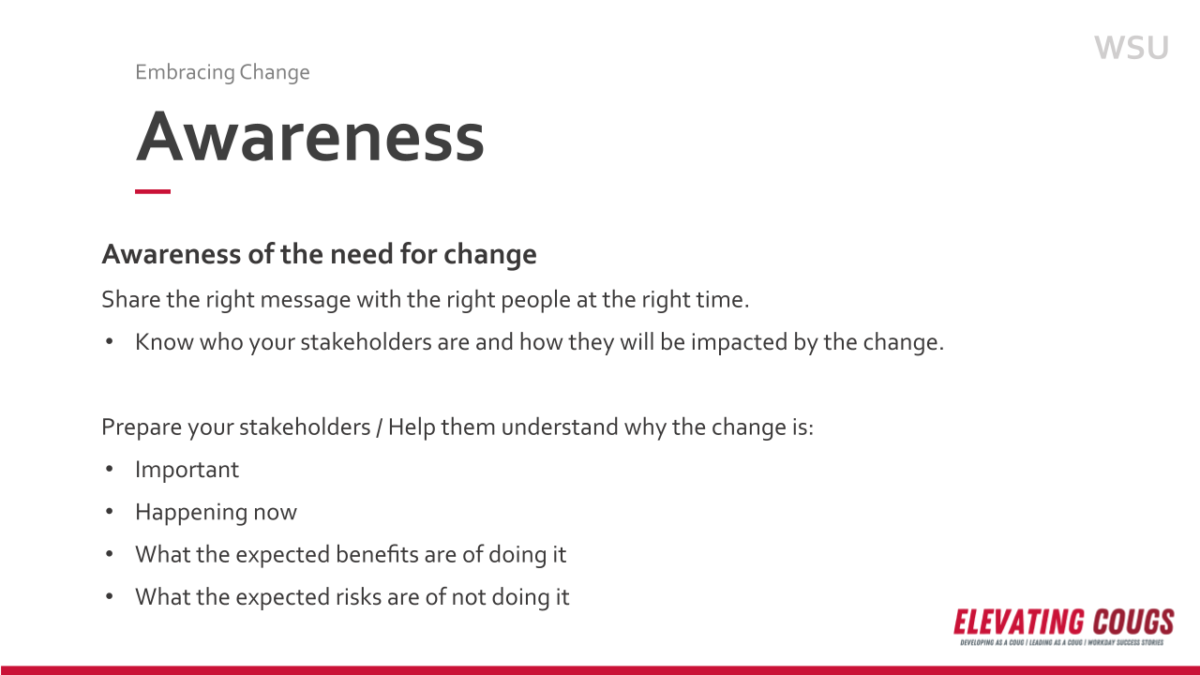
Awareness of the need for change:
Share the right message with the right people at the right time.
- Know who your stakeholders are and how they will be impacted by the change.
Prepare your stakeholders / Help them understand why the change is:
- Important
- Happening now
- What the expected benefits are of doing it
- What the expected risks are of not doing it
For this first step, really knowing who your stakeholders are is important.
Your stakeholders are everyone that is impacted by the project.
Now, your stakeholders aren’t a bunch of WSU IDs or position numbers, or sup org numbers in a spreadsheet. Your stakeholders are people with whom you want to build strong working relationships with.
If you don’t have those working relationships, now is a great time to start building them.
Desire

Gerik:
After Awareness in the ADKAR model, is Desire.
To successfully manage change, we need to develop and grow the desire to participate in the change.
Desire to participate & support the change:
The way you provide your message through websites, videos, training manuals, and presentations should encourage participation and confidence in the change.
- In short, the messaging should be helpful.
- Put a human face to the change, don’t hide behind surveys or cold, bulk emails.
Your stakeholders’ voice makes a difference to the success of the project. Share how you would like your stakeholders to help you:
- Provide feedback
- Help with testing
There is no right or wrong way to develop desire, but common approaches include providing information through websites, videos, newsletters, training manuals, and presentations. The messaging should be helpful and thoughtful.
Feedback is critical to ensure the desire is increasing especially for major changes.
Relating back to our legacy systems, there was a big desire to modernize our systems because AIS was beginning to have failures. Our saving grace was having fantastic teammates supporting those systems but there weren’t very many experts available to support it. Institutionally, we were aware of these issues, and we had the desire to make the change.
Knowledge & Ability

Paul:
This is the practical part of the behaviour changes that are needed.
Knowledge on how to change and Ability to implement required skills & behaviors:
Share:
- The behaviors you want your stakeholders to have tomorrow
- How your stakeholders can transition from what they’re doing today to what they need to do tomorrow
Provide easy to access:
- Training
- Documentation
- Communication around updates and training offerings
- Be available for questions
Ask yourself, what behaviours do you need your stakeholders to have tomorrow, and how can you encourage that?
You answer that by providing materials and communications that encourage the new behaviours that are needed, and remove the barriers that stop those behaviours from forming.
Making yourself available, being a friendly face people know they can contact, will make such a difference here.
When you’re training and demonstrating the software or the product that is delivering the change, you need people to learn new ways of doing things, but when people can’t reach the info they need they get frustrated and resistant. It’s human nature.
How many times has your bank or other service provider instructed you to go online to find the info you need. But when you can’t find it, what do you do? You revert to the dreaded phone and call them. Only to be stuck in an automated system, that you’re pretty sure is designed to prevent you from talking to someone and so you hang up.
Maddening, isn’t it?
But what if you picked up the phone and you could talk to someone, who actually helped you?
Having a personal touch here makes all the difference. Training is the same. You don’t need a huge call centre with a cast of thousands to answer the phones all day.
A knowledge base and a ticketing system are great ways to handle questions at scale and provide answers at the time they’re needed. But when someone can’t find the info they need, it’s nice to know there is another, more friendly way to get help.
This thought for human interaction also helps bring confidence and trust to the project.
This is why, for me, successful change managers care about the people being impacted by the change and put themselves into the shoes of the people they want to help.
Reinforcement
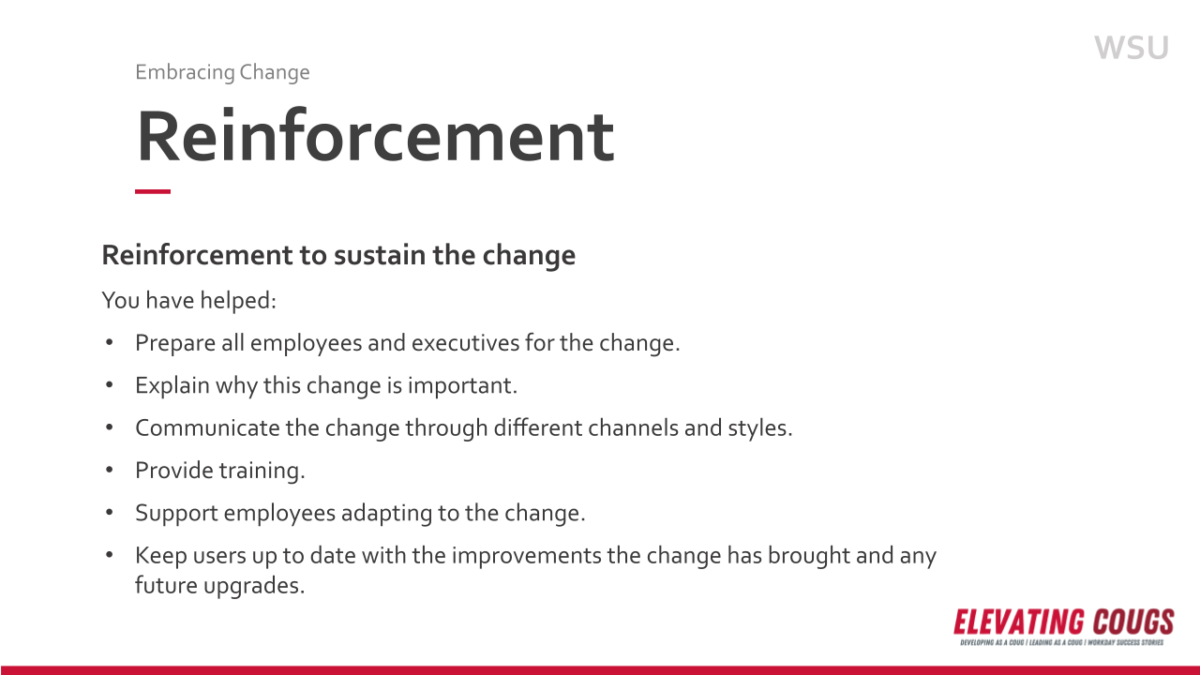
Gerik:
After Awareness, Desire, Knowledge, and Ability comes Reinforcement.
Reinforcement to sustain the change:
You have helped:
- Prepare all employees and executives for the change
- Explain why this change is important
- Communicate the change through different channels and styles
- Provide training
- Support employees adapting to the change
- Keep users up to date with the improvements the change has brought and any future upgrades
It’s important, especially in critical times, to reinforce the reasons why we are making the change.
We must support our employees through the change and remind them why the change is important.
We should coach the outcomes we are looking for and avoid criticism.
Lastly, we need to learn from gaps, listen to feedback, and prepare for our next change!
Takeaways
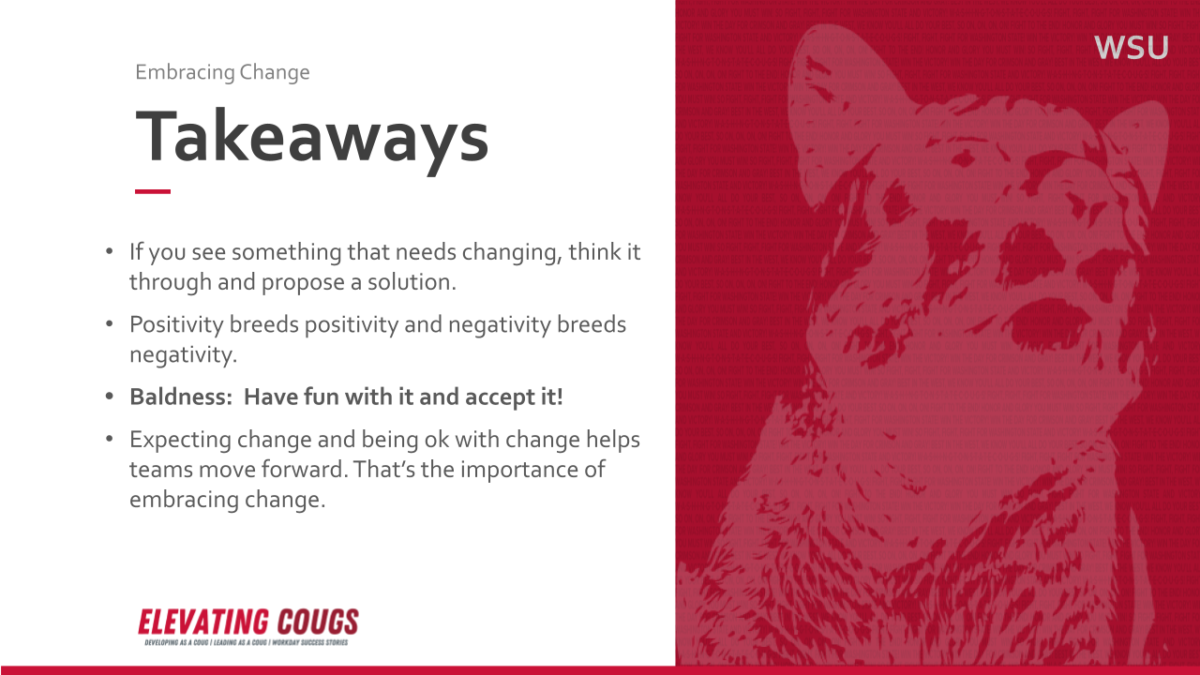
Gerik:
Embrace change! It’s coming!
If you see something that needs to change, be thoughtful and propose a solution!
Be positive! Positivity is contagious. Join me and Paul in a “yes we can” attitude.
Be bald! Kidding! I’m bald, I know it. I’ve accepted it.
Often, I use my baldness to crack jokes, to have fun, and to show that I’m proud to be in the bald club.
Expecting change and being OK with change helps teams move forward. That’s the importance of embracing change.
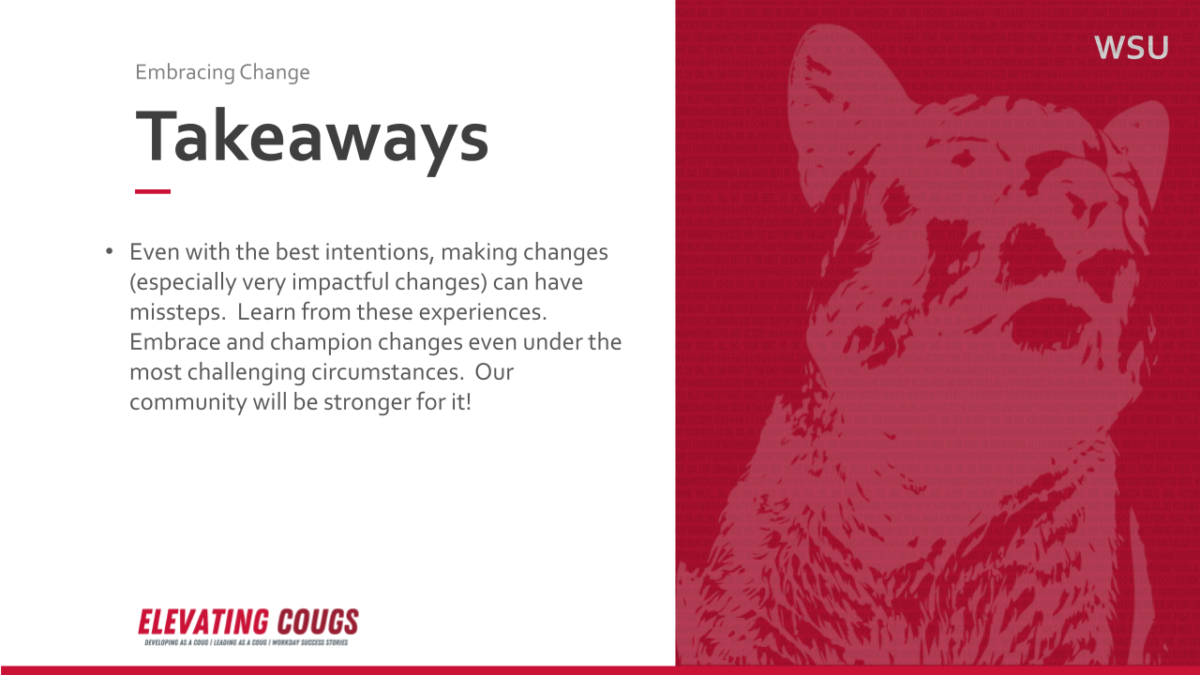
Paul:
Even with best intentions, not every aspect of your change management plan will be perfect or a hit with everyone. Because we’re talking about human beings, people with souls and emotions. And we don’t all react the same or relate to the same things as each other.
So if things don’t go to plan, learn from them.
Figure out what worked and what didn’t. And the next time you need to do change management, improve on what’s gone before and do things differently.
Don’t do the things that didn’t work. Do more of the things that did work.
Ultimately, what’s important is that you put yourself out there and you tell people why the change is happening, what the impacts are, and what people need to do to take advantage of it.
Paul Fleming McCullagh
Why? Because we’re human, and we much prefer to know what’s going on than to be left in the dark.





